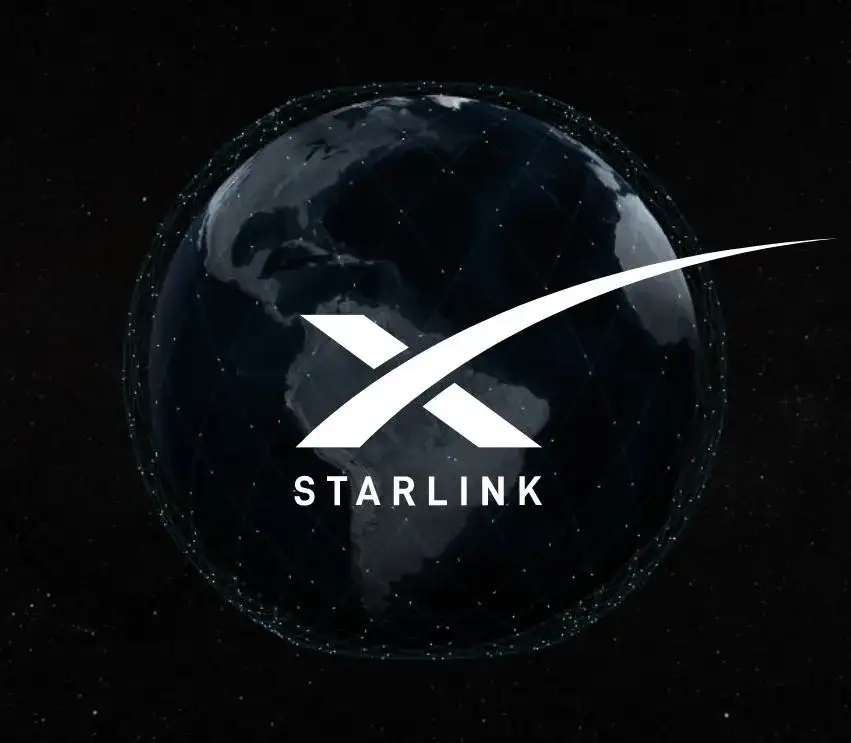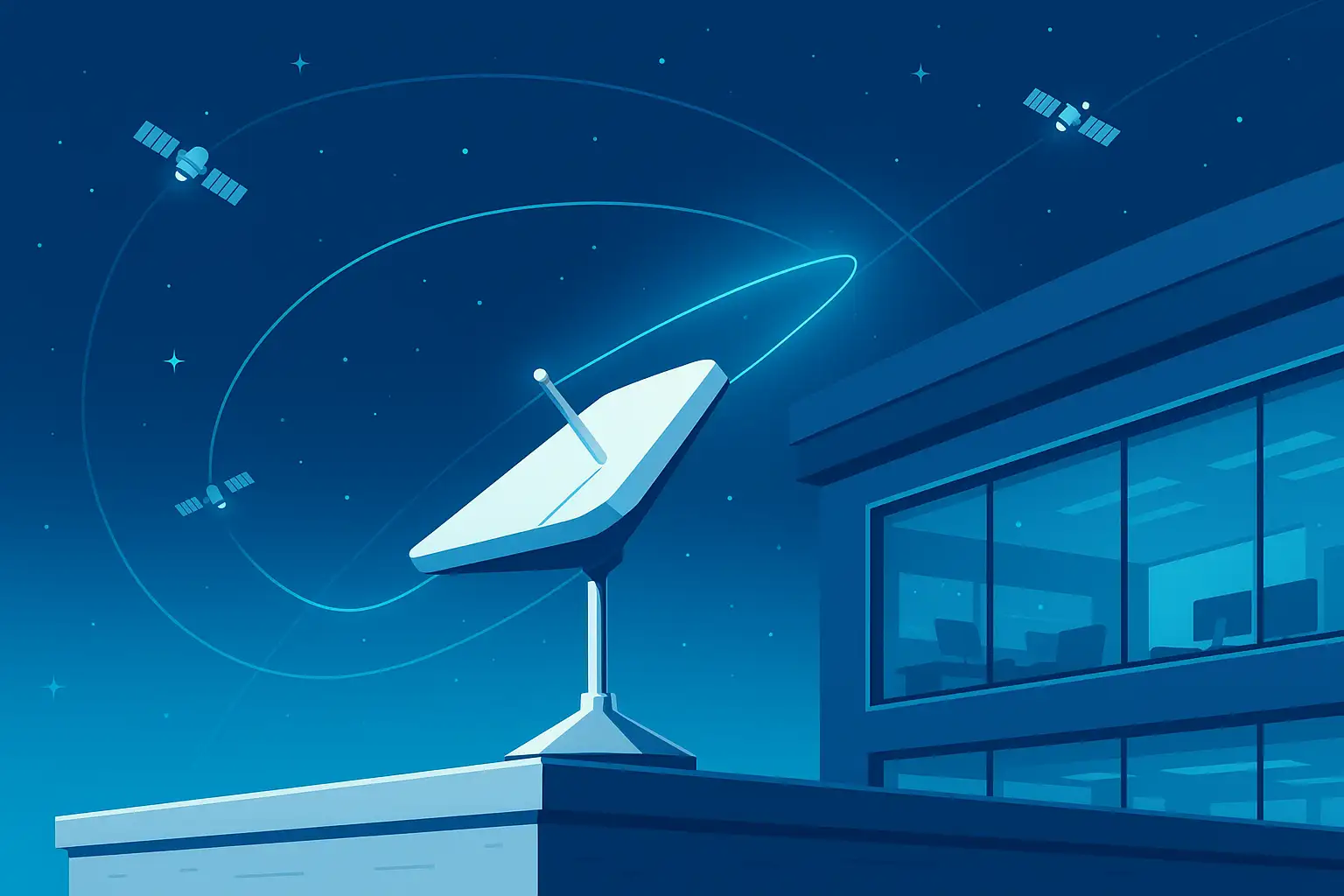The internet in businesses today isn't just a convenience—it's the foundation of most businesses. Without internet access, you can't send an email, issue an invoice, conduct an online conversation with a client, or log into an ERP system or accounting program. In short, internet downtime often means business downtime.
For many companies in large cities, this problem is practically nonexistent – fiber optic or high-speed cable connections provide a stable connection for 99% of time. However, once we move away from the city center, the situation is completely different. In smaller towns, industrial areas, remote offices, or mobile service points, internet access can be limited, and unfortunately, outages are more frequent.
This is where he comes onto the scene Starlink – modern satellite internet created by SpaceX, which revolutionized the way we think about connectivity. Thanks to a global network of low-orbit satellites, it became possible to provide high-speed internet virtually everywhere – from mountain villages, to construction sites in the middle of nowhere, to rural production halls.
In this article, I'll show you what Starlink is, how it works, in what situations it works best, and – most importantly – how you can implement it in your company to make it a reliable tool, not just a technological curiosity.
There will also be something specific: I will discuss real implementation of Starlink in a manufacturing company employing over 200 people, which thanks to it eliminated the risk of production downtime caused by internet failure.
Finally, I will show you step by step what the Starlink implementation process for your business looks like and how we can help you with the purchase, installation, and configuration – so you can enjoy fast and stable internet without the stress of “something going wrong.”

What is Starlink and how does it work?
Starlink is a satellite internet delivery system that was created on the initiative of the company SpaceX – the same one that sends rockets into orbit and builds spaceships. However, it differs from traditional satellite solutions we've known so far. Instead of a few large satellites placed very high above Earth (around 36,000 km), Starlink uses thousands small satellites placed in low orbit – approximately 550 km above the surface.
This solution has several key advantages:
• Lower latency (ping) – the signal travels a shorter distance, so the internet works more smoothly, which is important in videoconferencing or working on remote systems.
• Higher speeds – in many places Starlink achieves speeds comparable to fiber optics.
• Greater accessibility – coverage covers areas where fiber optic or LTE do not reach.
What does the Starlink kit look like?
The standard set includes:
Satellite dish (“Dishy”) – automatically aligns itself towards the satellites, without the need for manual adjustments.
Wi-Fi router – distributes the signal throughout the office or hall.
Wiring and power supply – easy to connect, no specialist knowledge required.
The entire system is designed for maximum simplicity of installation. In a home environment, simply place the antenna in an open space and connect the cable. In businesses, we typically mount it on a roof or other location with a full view of the sky, ensuring the best signal.
How does the connection work?
Antenna connects to the nearest Starlink satellite in low orbit.
The signal goes to a ground station, which is connected to the fiber-optic internet.
Data is sent back to your antenna via satellites and your router – all in a fraction of a second.
Speeds and delays in practice
• Download speed: typically 100–250 Mbps.
• Upload speed: about 10–25 Mb/s.
• Latency (ping): often below 40 ms, which is an excellent result for satellite internet.
Thanks to this technology, your business can operate without disruption even where slow and unstable wireless or LTE internet was previously the only option. And when you connect Starlink to your existing cable connection in backup mode, you benefit almost 100% guarantee of online work continuity.

Starlink applications in business
Starlink isn't just a technological curiosity—it's a tool that can become a key element of many companies' IT infrastructure. Thanks to its mobility, independence from local vendors, and high operational speed, it's suitable for a variety of industries and scenarios.
Below you'll find six practical examples that show where Starlink can make the biggest difference.
Main internet connection in locations without fiber optic
Not every company is fortunate enough to operate in a location with high-speed cable internet. In smaller towns or industrial areas, the only options are often LTE or wireless internet, which can be slow and unreliable. Starlink allows you to bypass this problem – all you need is an antenna with a view of the sky, and your company can enjoy internet speeds comparable to city fiber.
Backup link
In companies where internet outages mean real financial losses, a backup connection is not a luxury, but a necessity. Starlink can operate in parallel with the main cable connection – if one fails, traffic automatically switches to the other. This is especially important in manufacturing, e-commerce, or call centers, where every minute without network means lost orders or halted production.
Mobile offices and construction sites
Construction, surveying, and design firms often face a lack of telecommunications infrastructure in the field. Starlink solves this problem in a single day – the kit can be mounted on the roof of an office container or trailer, providing employees with internet access on-site. This accelerates document exchange, communication with the investor, and ongoing project monitoring.
Internet for agriculture and farm automation
More and more farms are using monitoring systems, automatic feeders, irrigation systems, and even remotely controlled machinery. All of this requires stable internet. Starlink gives farmers access to high-speed networks in places where traditional connections would never reach—for example, on large farms in rural areas.
Emergency link for e-commerce and call center
Companies operating in online sales or telephone and online customer service must be available around the clock. Losing your internet for even an hour can mean dozens of lost orders and dissatisfied customers. Starlink in emergency mode is a simple safeguard against such situations.
Internet in service points located far from cities
Auto repair shops, hotels, resorts, and gas stations often operate in locations where fiber optics are a dream. Starlink gives them an advantage: they can offer customers fast Wi-Fi, make online reservations, and use modern checkout systems without delays.
It's worth knowing: Regardless of the scenario, Starlink in the company can be configured as a primary or backup link, and can also be integrated with the existing network to switch between them automatically.

Starlink's Advantages and Limitations
Every technology has its strengths and weaknesses, and Starlink is no exception. To make an informed decision about implementing it in your company, it's worth understanding both the advantages that can revolutionize your daily operations and the limitations that must be considered when planning.
Advantages of Starlink
1. High speed and stability
Starlink offers download speeds of 100–250 Mbps and upload speeds of 10–25 Mbps. This speed matches or exceeds traditional cable connections in many locations.
2. Low latency
Thanks to the satellites' low-orbiting nature, latency (ping) is often below 40 ms. This is a huge difference compared to traditional satellite internet, where latency could reach several hundred milliseconds.
3. Independence from local infrastructure
Starlink works where there's no fiber, cable, or even LTE. All you need is a view of the sky and an antenna array.
4. Mobility and quick assembly
The Starlink kit can be installed in a new location in a single day – and if your business is relocating or operating remotely, the antenna can be packed up and taken with you.
5. Perfect as a backup link
Combined with the main cable connection, Starlink ensures near-continuity of business operations – the failure of one supplier no longer means work paralysis.
Starlink's Limitations
1. Costs
The starter kit costs several thousand zlotys, and the monthly subscription is several hundred zlotysAs a backup link, this can be a significant investment, but for many companies, the cost is justified by the lack of downtime.
2. Antenna location requirements
The antenna requires an open space with a view of the sky – trees, buildings or other obstacles can reduce the signal quality.
3. Impact of extreme weather conditions
Rain or snow usually does not cause interruptions in service, but very heavy rainfall may temporarily reduce speeds.
4. Power dependency
Starlink requires a constant power source – in the event of a power outage, it may be necessary to use a UPS or generator.
To sum up "Starlink isn't a magic solution that will always work perfectly everywhere. But for many companies, especially where internet is weak or outages are frequent, it can become a key infrastructure element. And if you connect it to an existing connection in backup mode, you'll gain truly solid protection against downtime."
Comparing Starlink to other types of business internet
Choosing a company internet connection shouldn't be based on hearsay, but rather on a thorough comparison of available options. Starlink is a unique solution, but it's not always the best choice as a sole connection. In many cases, it can work well in conjunction with other technologies, creating a robust "primary and backup" system.
Below you will find a comparison of Starlink with the most popular types of internet used in businesses.
Starlink vs. fiber optic
Fiber optic – advantages:
• Highest speeds (up to 1 Gb/s and more).
• Very low latency (less than 10 ms).
• Consistent, predictable connection quality.
Fiber optic – limitations:
• Available mainly in cities and larger towns.
• Requires physical connection – no mobility.
Starlink – Advantage:
• It works where there is no fiber optic cable and won't be for a long time.
• Mobile – you can move it.
Application:
If you have fiber optic – Starlink is not really needed as a main connection, but it will work great as a backup.
Starlink vs LTE/5G
LTE/5G – advantages:
• Wide availability.
• No need to install a large antenna.
• Often lower initial cost.
LTE/5G – limitations:
• Variable signal quality – depends on distance from the transmitter and network load.
• Transfer limits or speed restrictions when the package is exceeded.
Starlink – Advantage:
• Stable speeds regardless of transmitter congestion.
• No data limits on the standard business plan.
Application:
LTE/5G works well as a mobile or emergency link in places with good coverage, but Starlink will be more stable in locations far from the masts.
Starlink vs. radio internet
Radio internet – advantages:
• Possibility of installation in places without cable or optical fiber.
• Lower costs than satellite internet.
Radio internet – limitations:
• Strong dependence on weather conditions and terrain obstacles.
• Lower speeds, often unstable.
Starlink – Advantage:
• Independent of terrain obstacles (trees, buildings).
• Higher and more stable speeds.
Application:
Starlink is a direct competitor to wireless radios – in most cases it will perform better, although at the cost of a higher initial investment.
Best practice for companies:
In critical business environments, it's worth combining two different technologies—for example, fiber optic as the primary link and Starlink as a backup. This ensures that a single provider's outage won't disrupt business operations.

Case study – How we implemented Starlink in a manufacturing company (200+ people)
One of the large manufacturing companies in the Błonie area, employing over 200 people, was struggling with a problem that seemed minor in theory, but in practice could generate real losses – downtime in internet access.
Initial situation
The company used a high-speed fiber-optic connection as its primary internet access. Everything worked fine… until a provider-side outage occurred. Even a loss of connection for just a few minutes meant:
• interruption of work in ERP systems,
• no possibility of communication with contractors,
• suspension of goods shipment processes,
• delays in production planning.
Worse still, failures could occur at the most inopportune moments – for example, during the shipment of large orders or at the end of the month, when the accounting department had to send documents to clients.
Our task
The goal was providing a backup, fully automatic internet connection, which will take over all traffic in the company in the event of a failure of the main supplier without manual intervention by IT staff.
We considered several options – LTE, wireless internet, and Starlink. After analyzing the location and company needs, the choice was obvious: Starlink.
Implementation process
Location analysis
We checked the possibilities of mounting the antenna – the company had an open roof without any terrain obstacles, which guaranteed ideal conditions for Starlink.Delivery and installation of equipment
We ordered the Starlink Business kit, designed for heavier loads. We mounted the antenna on a special roof mount that's wind- and weather-resistant.Integration with the corporate network
We have configured a failover system so that if the fiber optic connection is lost, traffic automatically switches to Starlink – without interrupting user operations.Performance tests
We simulated a main link failure – the switchover took a few seconds, and employees did not notice any difference in the performance of applications and systems.Handover and training
We trained the IT team in basic system operation and connection status monitoring.
Effect
Several months have passed since the implementation, and the company hasn't experienced a single downtime due to internet outages. Even when the fiber optic provider experienced an outage, production and communications continued uninterrupted.
Benefits for the company:
• 100% online systems continuity.
• No losses resulting from delays in order fulfillment.
• Greater peace of mind for management and the IT department.
Why is it worth entrusting the implementation to us?
While installing Starlink may seem simple, for businesses it is important proper integration with existing infrastructure, switching configuration, and stable antenna mounting. Our implementation guarantees that the system will operate reliably at all times – without unnecessary downtime or surprises.
If your company cannot afford downtime due to an internet outage, please contact us.
We will deliver, install, and configure Starlink so that you can be sure that even in critical situations your business operates without disruption.

What does Starlink implementation look like in a company – step by step?
Although Starlink is marketed as "plug and play," in a business environment, the implementation process should be carefully considered and tailored to the specific infrastructure. The goal is to ensure that satellite internet not only works but actually fulfills its intended purpose—whether as a primary connection or a backup.
Below I describe what the full implementation process looks like in a company, based on our experience.
Step 1: Needs and Location Analysis
We begin with a conversation and audit. We determine:
• whether Starlink will be the main or backup link,
• what is the current network infrastructure,
• whether the location allows for trouble-free signal reception (full view of the sky).
During this stage, we also analyze potential obstacles, such as tall trees or nearby buildings. If there's a risk of interference, we suggest alternative antenna mounting locations.
Step 2: Order the right kit
The choice of equipment depends on your needs:
• Starlink Standard – for smaller offices or companies that want to use it mainly in the field.
• Starlink Business – for larger organizations, with a larger antenna and priority access to the network.
We handle the entire ordering process – from registration to delivery of the equipment to the specified address.
Step 3: Mounting the antenna
The antenna should have a stable, wind-resistant mount and be positioned in a location with maximum sky visibility. It's most commonly mounted:
• on the roof of the building,
• on a dedicated mast,
• or on a special wall bracket (in the case of mobile offices – on the container structure).
During installation, we use additional protection for the cables and the antenna itself to ensure it is weather-resistant all year round.
Step 4: Integration with the corporate network
This is one of the most important steps – especially if Starlink is to act as a backup link. We configure:
• router and firewall,
• automatic switching system (failover) between the main and backup links,
• priority rules so that in the event of a failure, employees can work without disruption.
This allows the switch to take place in seconds, without users having to do anything at all.
Step 5: Testing and Optimization
We simulate a main link failure and verify how the network behaves in practice. We test:
• connection speed and stability,
• switching time,
• correct operation of key applications (ERP, email, VoIP, video conferencing).
At this stage, we can also optimize QoS settings (traffic prioritization), so that, for example, Teams conversations take priority over large file downloads.
Step 6: Handover and Training
Finally, we deliver the implemented system and conduct a short training session for IT administrators or infrastructure managers. We teach them how to check connection status, how the switching system works, and what to do in case of problems.
Thanks to this approach, the company is sure that Starlink is not just an "additional router on the roof," but a real safeguard against downtime.
How much does Starlink cost in a company?
The cost of implementing Starlink in a company consists of several elements: the purchase price of the equipment, the monthly subscription fee, and any installation and network integration costs. It's an investment that pays off quickly for many companies, especially if efficiency is key. continuity of work and no downtime.
The cost of purchasing the Starlink kit
The price depends on the chosen version:
• Starlink Standard – approx. PLN 2,300–2,800 net
• Starlink Business – approx. PLN 11,000–12,500 net (larger antenna, priority connection, higher load resistance)
For a small office, the Standard version is sufficient, but for large plants or companies with intensive internet traffic, we recommend Starlink Business.
Monthly subscription
• Starlink Standard – approx. PLN 230–260 net / month
• Starlink Business – approx. PLN 1,100–1,300 net / month
The Business plan not only provides network priority, but also greater stability under heavy load – which is important in a multi-user environment.
Installation and integration costs
If a company decides to install it itself, this cost is eliminated – however, in the case of a business, it is worth investing in professional implementation, which includes:
• antenna installation taking into account weather conditions,
• securing cables and equipment,
• integration with existing network infrastructure (router, firewall, failover system),
• connection testing and optimization.
Professional implementation usually costs from 800 to 2,500 PLN net, depending on the complexity of the installation.
Comparison with other emergency solutions
• LTE/5G – lower initial cost, but less stable connection, especially during peak hours.
• Radio internet – often cheaper, but sensitive to weather conditions and terrain obstacles.
• Fiber optic from two suppliers – theoretically the best solution, but in practice often impossible in locations far from cities.
In this context, Starlink can be a golden mean – the costs are higher than with LTE, but the stability and independence from local infrastructure make up for this difference.
It's worth remembering – even if Starlink is used only as a backup link, the monthly cost may be small compared to the losses generated by a few hours of downtime in the company's operation.
How we can help you set up and maintain Starlink
If you've reached this point in the article, you already know that Starlink can be a powerful tool in a company's infrastructure. You also know – after our description of the implementation at a manufacturing company – that we already have practical experience in working with this technology. That's why we can provide you with support from the first step to ongoing maintenance.
Choosing the right set
We'll help you decide whether Starlink Standard or Business is the better choice for you. We take into account your company's size, number of users, workload, and whether the connection will be primary or backup.
Professional installation and configuration
• We select the optimal antenna mounting location to ensure maximum range.
• We install equipment in a safe and weather-resistant manner.
• We integrate Starlink with your corporate network, configuring automatic failover in the event of a main link failure.
Testing and optimization
Our work doesn't end when the cables are connected. We test the connection in practice, verifying the performance of key applications (email, ERP, VoIP, video conferencing) and optimizing settings to ensure smooth operation throughout the company.
Employee training
We convey knowledge in a simple, understandable way – so that people responsible for IT in the company know how to monitor the system's operation and what to do if necessary.
Constant care and service
If you wish, we can provide ongoing care for your Starlink – monitor its operation, update its software, respond to reports, and resolve issues before they impact your daily work.
Thanks to the experience we have already gained in implementing Starlink in business, we can act quickly, efficiently and without the risk of unnecessary downtime.
If you're considering this solution for your company, contact us. We'll analyze your needs and prepare an implementation tailored to your workflow.
Frequently asked questions
Does Starlink work in all weather conditions?
Can I use Starlink as my company's main internet connection?
How long does installation take?
Does Starlink require constant power?
Does Starlink work in motion (e.g. in vehicles)?
What are the data transfer limits?
Starlink is a solution that opens up new opportunities for businesses – whether you operate in a city center or in a location where fiber optic is only a temporary option. It can be a fast, stable, and fully independent internet source, or an effective backup link.
Thanks to it, you will avoid downtime, gain peace of mind and the certainty that your company will be online even if your main supplier fails.
If this topic concerns your company, please contact us.
We will take care of everything: from equipment selection, through assembly, to integration and constant care service.





